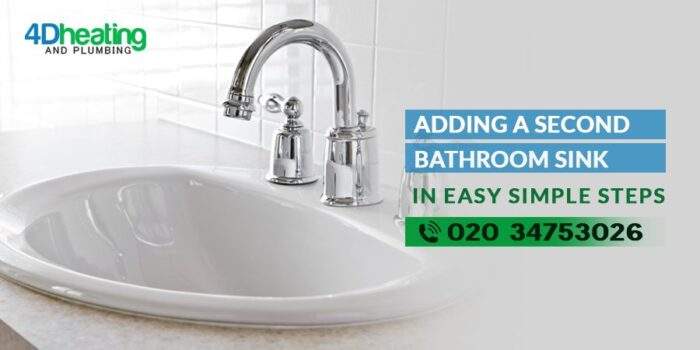Adding a Second Bathroom Sink in Easy Simple Steps
Are both you and your spouse career professionals? If yes, then you must know how a double sink basin is a lifesaver while getting ready for work in the morning. While creating a double-sink vanity top, either you install a brand new countertop or you’re just installing a second sink alongside the existing one. When people install a brand new countertop, they usually choose the variety that comes with two basin cutouts. On the other hand, while installing a second sink, they usually cut an opening in the countertop and join the existing water supply and drain lines to the new sink.
A group of qualified plumbers based in London explains how the existing water supply and drainage lines are joined to the new sink in the following portions of this blog post.
Skills required
Our friendly plumbers in London are of the opinion that this task in not exactly an ideal DIY initiative as it requires intermediate to advanced skill levels. In addition to that little experience is furthermore better to get the job done smoothly.
Solid-surface and laminated counters are still DIY-friendly to some extent. But marble, granite or quartz tops are practically meant for professionals to work upon. Your untrained hands are likely to crack up the surface. Moreover, dust particles coming out from stone tops will invariably affect your health because unlike a qualified plumber you don’t know how to tackle them.
You will require a range of basic plumbing tools along with some tools used in home workshop to execute the project.
Lastly, the plumbing pipes are likely to vary greatly. Make sure that you are comfortable with the piping system that already exists in your sink. Reach below the sink to know the type of pipe that you need.
Tools and materials
An emergency plumber in London suggests preparing the following tools to execute the work. It is not that you will need each and every tool mentioned in the list. But you may need them depending on the situation that you find yourself in.
- Tape measure
- Marker
- Jigsaw
- Bits and drill
- A pair of flexible water supply tubes
- Hacksaw
- New sink along with drain and faucet assembly
- Plumbing putty
- Silicone caulk
- Adjustable wrench
- Chanel-lock pliers
- Caulk gun
- Basin wrench
- A pair of dual-outlet fixture shutoff valve
- PVC drain trap along with suitable elbows, extensions and tee-fittings
Points to take note
- Carefully cut the hole for the sink
- You’ll attempt this step only if you have a solid-surface or a laminate countertop. To use the two sinks simultaneously side by side, they must be spaced at least 24 inches apart although 30 inches is a better option.
- Start with carefully measuring the shape that you have to cut on the existing countertop. The challenging part of the job involves keeping up with the right spacing and alignment.
- After you’ve outlined the sink opening on the countertop, drill a hole through the countertop within the outlined area. Remember, the hole must be large enough to hold a jigsaw blade.
- Cut along the outline using a jigsaw to finish the sink cutout.
- Test the new sink to ensure it fits perfectly.
Assembling and installing the new sink
- Installing the drain fitting and faucet to the new sink should be easier at this stage. Accessing the tailpieces of the faucet can be difficult once the sink is placed on the countertop. So you can fix the water supply pipes to the faucet tailpieces beforehand.
- Place the faucet on the sink by inserting the tailpieces of the faucet through the holes made on the sink. Then thread the mounting nuts on the tailpieces from under the sink. Apply a thin layer of plumbing putty between the sink and the faucet base. There is a foam or rubber gasket on other faucets that makes putty unnecessary.
- Fix the flexible water supply tubes to the cold and hot tailpieces. These tubes must be long enough to cover the distance between the sink and the shutoff valve located beneath the countertop. Use a suitable wrench to tighten the supply tubes to the tailpieces.
- Stick to the manufacturer’s guideline while installing the drain assembly on the sink. Some mounting nuts and tailpieces are made of plastic. Make sure over-tightening does crack or break them.
- Make sure to wipe away any plumbing putty that may have squeezed out of place from around the drain fitting flange.
- Qualified mechanics associated with boiler installation in London suggest now is the time to carefully insert the sink into the countertop cutout. Apply silicone caulk across the opening of the cutout and then lower the sink in place.
If it is possible, apply a bead of caulk around the seam, in between the countertop and the sink rim. Use a damp cloth to wipe away any excess caulk.
Connecting the drain pipes
- In the next step, you have to connect the drain pipes. This step involves working under the sink. When your sinks are placed 30 inches apart or less, you can serve them with the same P-trap. You may require different transition fittings but that depends on the situation you are in.
- Disconnect both the drain trap and drain pipes at the bottom of the existing sink. You have to use channel-lock pliers for the purpose. Depending on the situation you may also have to cut the pipes free with a hacksaw. Get rid of the tail piece extension that drops down from the existing sink along with the P-trap and the trap arm that connect to the drain opening in the wall.
- Join the pieces to link both the sink drains to a single P-trap. Usually this requires 90-degree elbows at the bottom of each drain tailpiece. It joins to the tee-fitting, while a short pipe runs from the Tee-fitting to the P-trap. A trap arm pipe is used to join the P-trap outlet to the drain opening in the wall.
- In order to ensure smooth draining, pitch the trap arm that leads into the drain opening downward at a slope of about ¼ inch per foot.
- Once the drain pipes are properly fixed, use channel-lock pliers to tighten up all the slip-joint connections.
Joining the water supply lines
- The last step involves connecting the water supply lines. That is you will replace the existing fixture shutoff valves with double-outlet shut off valves to ensure both sink faucets are fed at the same time. Choose the variety of shut off valves that your pipes compliment.
- Disconnect water supply at the main shutoff valve. Do not forget placing an empty bucket below the water supply valve before working out this step.
- Cut off the supply tubes that cater to your existing sink from the shutoff valves. You may require adjustable wrench or channel-type pliers for the purpose. You may also require using two wrenches, one for holding the valve and the other to loosen the nut on the supply tube.
- You have to remove the fixture shutoff valves from the water supply stub-outs. In order to achieve this you need loosening the compression fitting nuts using a wrench.
- Make sure the new dual-outlet shut-off valves are attached to the water supply stub outs. Stick to the manufacturer’s guideline in this aspect.
- Connect the free end of each faucet supply tube to the right valve with help of an adjustable wrench. Match the hot water supply tubes to the hot water shut-off valve while the cold water supply tubes to the cold water shutoff valve.
Now you are almost done, assure skilled plumbing mechanics at 4D Heating and Plumbing – a reliable plumbing company in London. Open the main water supply valve first and then open the fixture shutoff valve. Do not forget testing the both faucets on the two sinks. There can be leaks both in drain fitting and water supply fitting. Tighten the connection or connections that show leaks.







